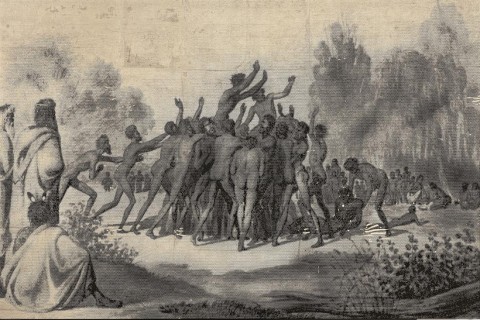AUSTRALIA I, 2012
BROOK ANDREW
mixed media, silkscreen and gold foil on Belgian linen
200.0 x 300.0 cm
Tolarno Galleries, Melbourne
pARTners Art Collective, Melbourne, acquired from the above in September 2012
The Basil Sellers Art Prize, The Ian Potter Museum of Art, University of Melbourne, Melbourne, 3 August – 4 November 2012, cat. 1 (another example)
DARK HEART Adelaide Biennial of Australian Art, Art Gallery of South Australia, Adelaide, 1 March – 11 May 2014 (another example)
Wearne, S., ‘Brook Andrew’, Basil Sellers Art Prize 2012, Ian Potter Museum of Art, University of Melbourne, Melbourne, 2012, pp. 8 (illus., another example), 9
Nelson, R., ‘Lofty Jocks Strapped for Meaning’, Sydney Morning Herald, Sydney, 19 September 2012
McSpedden, S., ‘Howzat! : An Australian Spin on Sport and Art’, Eyeline Contemporary Visual Arts, Eyeline Publishing Limited, Brisbane, issue 78/79, 2013 [https://www.eyelinepublishing.com/eyeline-78-79/review/howzat-australian... (accessed 3/07/19)
Mitzevich, N., DARK HEART: 2014 Adelaide Biennial of Australian Art, Art Gallery of South Australia, 2014, pp. 54 – 64 (illus., another example, dated as 2013), 184
Thomson, J., ‘Dark Heart: Adelaide Biennial’, Asian Art News, vol. 24, no. 3, May / June 2014, p. 44 (illus., another example)
Pesa, M., ‘Dark Heart: 2014 Adelaide Biennial of Australian Art’, Art Almanac, Sydney, March 2014, p. 47 (illus., another example)
Laurie, V., ‘Indigenous gems book passage to Asia for art tour’, The Australian, Sydney, 18 October 2018 (illus., another example)
Australia IV, 2013, mixed media on Belgian linen, 200.0 x 300.0 cm, in the collection of the Art Gallery of Western Australia, Perth
Australia VI Theatre and remembrance of death, 2014, mixed media on Belgian linen, 200.0 x 300.0 cm, in the collection of the Art Gallery of New South Wales, Sydney
Humans are social creatures, relying on sense of collective identity to ensure emotional and physical wellbeing. Brook Andrew’s impressive tableau, Australia I, 2012, is an acknowledgement of the vital role collective physical activity plays in the creation of a community. Based on a colonial ethnographic study from the late 1850s, the work depicts a group of Nyeri-Nyeri men from north-western Victoria participating in a game of marngrook, an indigenous precursor to Australian Rules football.1 Consequently, Australia I, 2012 was included in the 2012 Basil Sellers’ Art Prize, an award celebrating contemporary art works addressing sport, creating a bridge between the nation’s most revered pastime and its cultural counterpart.
This work is one of six large-scale historical scenes (Australia I – VI, 2012 – 2014) that re-present a selection of etchings by Gustav Mützel, a German artist who never stepped foot on the Australian continent. Commissioned by Prussian geologist and naturalist William Blandowski to immortalise the findings of his expedition to the Murray Darling basin in 1856 – 57, Mützel used original ethnographic sketches executed by Blandowski himself and his colleague Gerard Kreft to create composite illustrations. The drawings since lost, many of these images only remain in the minuscule photographic albumen prints composed by Mützel (each measuring 70 x 40mm) published in the illustrated account, Australien in 142 Photographischen Abbildungen, 1862, only two full copies of which are extant in libraries in Europe.2 The image upon which Australia I is based also exists as a photographic print in the Anthropology Library of the British Museum. Largely unseen by Australian people, indigenous or otherwise, these archives have recently been excavated by scholars and artists, stimulating a post-colonial critique of documentary images of indigenous Australians during the colonial period. Already employed in Andrew’s earlier series, The Island, 2008, examples of Blandowski’s visual documents are appropriated and transformed, their well-worn format blown up to a vast scale and applied by a screen-printing process to a coloured foil support.
The resulting effect is not dissimilar to that of a noble history painting of the Western canon. The drama of the cultural activities performed remains mysterious and opaque, their sacred nature concealed to uninitiated viewers. The subjects of this picture clamour for the invisible possum-fur ball or ball of plant roots, seeming to struggle to attain something intangible. Harnessed by a highly reflective gold foil, the light of discovery shines unevenly across the surface of the artwork. Throwing light on the glorification of the ‘noble savage’ in colonial archives, Brook Andrew’s Australia I takes this romantic view one step further, displaying it on the heroic scale hitherto denied to ‘ethnographic’ subjects. Andrew questions the very nature of representation, and the interaction between a truthful observation and voyeuristic colonial curiosity.
1. Wearne, S., ‘Brook Andrew’, Basil Sellers Art Prize 2012, Ian Potter Museum of Art, University of Melbourne, Melbourne, 2012, p. 9. The role of Marngrook or Marn-grook in the formation of AFL football in Victoria in 1858 has been suggested by numerous historians since the 1980s, and in 2008 it was included in the official history of the game by the Melbourne Football Club.
2. Allen, H., ‘Authorship and Ownership in Blandowski’s Australien in 142 Photographischen Abbildungen’, Australasian Historical Archaeology, Sydney, vol. 24, 2006, p. 32
LUCIE REEVES-SMITH
